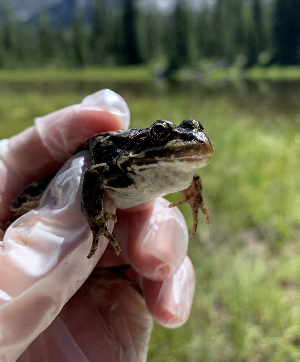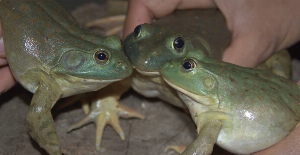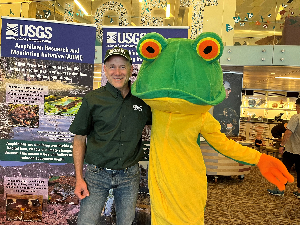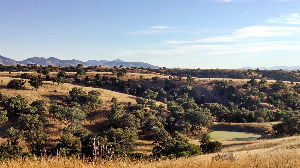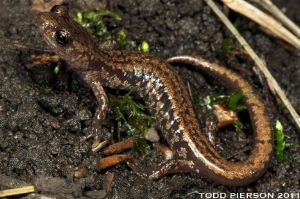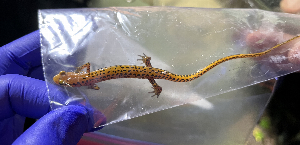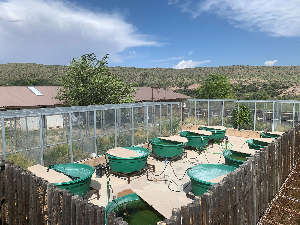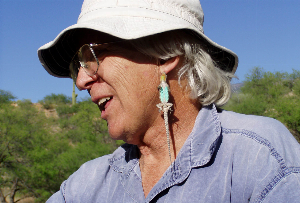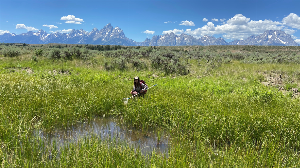Search ARMI Database
Search term(s)
Contribution Number
Search Results
85 record(s) found.
News & Stories Climate change and Cascades Frog
A new paper by Kissel et al shows how complex life cycles interacting with climate change can lead to counter-intuitive outcomes for amphibian populations: https://doi.org/10.1016/j.ecochg.2023.100081
News & Stories Broad-Scale Assessment of Methylmercury in Adult Amphibians
The first widescale assessment of methylmercury in adult amphibians in the U.S. shows that this toxic compound is common, widespread and, at least for some populations, can reach very high levels. The ARMI-led publication brought together scientists from around the country to test more than 3,200 amphibians representing 14 species from 26 populations. Amphibians are the most endangered group of vertebrates worldwide, but prior to this study, little information was available on mercury bioaccumulation in amphibians across the U.S.
Mercury is a contaminant of global concern that can harm humans and wildlife. In aquatic ecosystems, microbes can convert elemental mercury to methylmercury, which increases risks because methylmercury is more bioavailable, more toxic, and it biomagnifies through food webs.
Study results showed that the amount of methylmercury in amphibians varied widely among sites and by life history characteristics, such as diet, size, and sex. Amphibian methylmercury concentrations ranged from barely detectible at some locations, to levels above wildlife health benchmarks in others. The study also evaluated using dragonfly larvae to estimate bioaccumulation for amphibians that can’t be sampled because they are rare or secretive. Scientists determined that the concentration found in these insects can provide insight into methylmercury bioaccumulation in amphibians.
Despite its toxicity, scientists only have a limited understanding of methylmercury’s effects on amphibians and these results can be used to inform future research on the health effects of methylmercury exposure on amphibians. The study also provides new methods and baseline data that can help scientists and managers assess the risk from mercury for species of management concern, including species listed as threatened and endangered under the Endangered Species Act.
To view the full article click this link: https://pubs.acs.org/doi/10.1021/acs.est.3c05549
News & Stories It's Always Halloween When You Work on Toads
As first appeared in USGS NTK:
My late fall trek to Lost Lake in Rocky Mountain National Park to look for evidence of toad breeding is beautiful. The aspen leaves are golden. The air is downright cold at the 7 am start. The ten-mile hike starts downhill but soon angles up and continues up for the next eight miles. That is a lot of time to think about the end of another summer field season and about how few toads we observed. I can’t help but wonder if our field techs somehow overlooked breeding and egg masses? Or was it because it didn’t happen? It was only early October, but I settled in to a decidedly grim and early Halloween-edgy mood that was resistant to the bright blue of the sky and clung to me like a veil the rest of the hike.
Not a soul was camping at Lost Lake. The lake was still with only a few ravens providing their opinions on campers and, no doubt, toad conservation. All senses narrowed to look for a toadlet or an adult toad as I poked through the drying grasses and shrubs around the lake, and hopefully scanned the water’s edge. I could feel, more than see, the daylight dwindling.
On the far side of the lake I saw her, sitting on the shoreline. I stopped short as I saw the stiffness of her body and the blank white stare of her eye. The toad was dead. But hadn’t been dead long. I pulled out the “tools of the trade” and measured her, checked her for an identifying passive integrated transponder tag, and swabbed her to test for the amphibian chytrid fungus. She was not marked, and I only assumed she was a female based on size. I recorded a few bits of environmental data, and although firm-ish, the toad was in no condition to travel for further examination. I felt a chill and realized that the sun was completely gone. I left her on the shore with a quick prayer to the amphibian goddess and a furtive look around for moose.
Boreal toads, like the one I found, have been on the decline in Rocky Mountain National Park (RMNP), and the southern Rocky Mountain region for a while. One contributor to these declines is the amphibian chytrid fungus that thickens the skin, blocks osmosis (water intake), and eventually leads to heart attack and death. As a research zoologist, my colleagues and I have been working on amphibians in RMNP in northern Colorado for three decades. Our work ranges from questions of immediate interest to the National Park Service, like “how are the wood frogs doing with the hydrological changes on the west side of the park,” or “why are boreal toads declining” to overall management questions like, “what is the status of the amphibian species in the park and what factors may affect persistence?”
Although there are some bad days like my autumn hike to Lost Lake, there are glimmers of hope, or at least of gains in information that we might use towards amphibian conservation. We are currently working on a paper using three decades of data on chorus frogs, salamanders, and wood frogs in RMNP to examine changes in persistence over time across the landscape of the park. This work also considers a variety of mechanisms (e.g., visitor use) that may affect the probability of persistence and thus provides RMNP with information that can contribute to conservation decisions about the management of the park’s amphibians.
Erin Muths is a research zoologist at the Fort Collins Science Center and is a principle investigator for the Amphibian Research and Monitoring Initiative for the Ecosystems Mission Area. Her lab has studied boreal toads and other amphibians in the Rocky Mountains for more than 25 years. She is going to be sorcerer for Halloween.
News & Stories Do Your Halloween Plans Involve Eye of Newt? Newts Have Some Things They Want You to Know!
As first appeared in USGS NTK:
First of all, newts are not the villains, instead, they are often the victims.
Newts are at risk, along with many animals, from climate change and from disease. In fact, they could be poster animals for climate change: In southern California, recent record warm air temperatures along with peak drought conditions are linked with a 20% reduction in mean body condition (e.g., mass) in the California newt (Taricha torosa)*. The disease Batrachochytrium salamadrivorans (Bsal, literally eater of salamanders in Latin) has caused significant devastation to salamander populations in Europe. This fungal disease affects primarily newts and salamanders and the Northeastern U.S. is considered the salamander capital of the world. While Bsal is not present in the United States now**, there is serious potential for the disease to spread from Europe to the U.S. through the pet trade***.
Second, newts are quiet neighbors that contribute to society.
For example, newts eat a variety of insects, and they are eaten by birds, snakes, and some mammals.
Third, newts appreciate Halloween and keep it alive all year!
Newts have three distinct developmental life stages that are in effect, costume changes! They begin as aquatic larva, metamorphose into terrestrial juveniles (sometimes called efts), then metamorphose into adults.
And finally, newts value their eyes.
If you are really looking for some eye of newt, go look in your local grocery, “eye of newt” is actually a very un-scary and easily acquired mustard seed.
Erin Muths is a research zoologist at the Fort Collins Science Center and is a principle investigator for the Amphibian Research and Monitoring Initiative for the Ecosystems Mission Area. Her lab has studied boreal toads and other amphibians in the Rocky Mountains for more than 25 years. She is going to be sorcerer for Halloween.
Michael Adams is a supervisory research ecologist at the Forest and Rangeland Ecosystem Science Center and is the Lead for the Amphibian Research and Monitoring Initiative for the Ecosystems Mission Area. His lab has studied newts and other amphibians in the Pacific Northwest for the past 25 years. His Halloween plans are a mystery to everyone including himself.
References:
*Bucciarelli, G.M., Clark, M.A., Delaney, K.S. et al. Amphibian responses in the aftermath of extreme climate events. Sci Rep 10, 3409 (2020). https://doi.org/10.1038/s41598-020-60122-2
**Waddle, J.H., Grear, D.A., Mosher, B.A., Grant, E.H.C., Adams, M.J., Backlin, A.R., Barichivich, W.J., Brand, A.B., Bucciarelli, G.M., Calhoun, D.L. and Chestnut, T., 2020. Batrachochytrium salamandrivorans (Bsal) not detected in an intensive survey of wild North American amphibians. Scientific reports 10(1), p.13012.
***Connelly, P.J., Ross, N., Stringham, O.C. and Eskew, E.A., 2023. United States amphibian imports pose a disease risk to salamanders despite Lacey Act regulations. Communications Earth & Environment, 4(1), p.351.
News & Stories Successful eradication of invasive American bullfrogs leads to co-extirpation of emerging pathogens
Recent ARMI-led research showed the removal of invasive American bullfrogs from livestock ponds and small lakes in southern Arizona also resulted in the apparent local extirpation of two pathogens associated with the bullfrogs. The American bullfrog is native eastern North America but has become widespread in the West, where it preys on many native species of conservation concern. Other recent ARMI-led research from the area suggested that American Bullfrogs could act as reservoirs for pathogens like amphibian chytrid fungus (Batrachochytrium dendrobatidis; Bd) and ranaviruses, which are often lethal to native amphibians, but less so to American Bullfrogs.
In the early 2000s, American bullfrogs were eradicated from ponds in the Buenos Aires National Wildlife Refuge near the Arizona-Mexico border to assist with the reintroduction efforts for the federally threatened Chiricahua Leopard Frog. In 2015, the bullfrog reinvaded the refuge and was once again removed. This reinvasion from outside the refuge motivated funding for a multi-year, landscape-scale eradication program. In the fall-winter of 2016 and the winter of 2020-2021, the research team tested the water at bullfrog eradication and control (no eradication efforts occurred) sites for the DNA (environmental DNA or eDNA) of invasive bullfrogs, federally threatened Chiricahua Leopard Frogs, and Bd and ranaviruses.
Results from the eDNA sampling showed American Bullfrogs were eradicated successfully from most sites, and where bullfrogs were eradicated, the pathogens were also no longer detected. Chiricahua Leopard Frogs did not increase in occurrence after eradicating bullfrogs, possibly due to an exceptional drought that could have limited the ability of native amphibians to colonize sites.
To our knowledge, this is one of the few studies to link eradication of an invasive species to co-eradication of emerging pathogens. Our spatially replicated experimental approach provides strong evidence that management of invasive species can simultaneously reduce predation and disease risk for imperiled species.
To view the full article click this link: https://doi.org/10.1111/conl.12970
News & Stories Elevated road segment passage design may provide enhanced connectivity for amphibians, reptiles, and small mammals
Introduction: Designs for safe and effective road crossing structures for small animals are typically under-road microtunnels and culverts which have varying levels of effectiveness reported in the scientific literature. Many species, particularly migratory amphibians, may have limited ability to find and use passages if they are too far apart, resulting in substantial barrier effects.
Methods: We designed a novel open elevated passage (elevated road segment: ERS), similar to a low terrestrial bridge, that could theoretically be built to any length based upon species needs and movement characteristics. A 30 m length prototype ERS was installed along a forest road with a history of amphibian road mortality in Sierra National Forest, Fresno County, CA, USA. From 2018 to 2021, we monitored small animal activity under the ERS in relation to surrounding roadside and forest habitats using active infrared cameras.
Results: We documented a total of 8,815 unique use events, using species specific independence criteria, across 22 species of amphibians (3), reptiles (4), and small mammals (15). Poisson regression modeling of taxonomic group activity under the ERS, roadside and forest, showed that amphibian activity was highest in the forest habitat, no differences were observed for reptiles, and small mammal activity was highest under the ERS. However, mean activity estimates under the ERS were equal to or greater than the open roadside habitat for all 22 species, suggesting that adding cover objects, such as downed logs and vegetation may further enhance passage use.
Discussion: Overall, results showed that the design of the ERS crossing has potential to provide high connectivity for a wide range of amphibian, reptile, and small mammal species while reducing road mortality. ERS systems can also be used in areas with challenging terrain and other hydrological and environmental constraints. Incorporating current road ecology science, we provide supplemental ERS concept designs for secondary roads, primary roads and highways to help increase the options available for road mitigation planning for small animals.
To view the full article click this link: https://doi.org/10.3389/fevo.2023.1145322
This is one of many research studies USGS is conducting to inform safe and effective road crossing systems for amphibians and reptiles. See https://www.usgs.gov/centers/werc/science/reptile-and-amphibian-road-ecology for more information.
News & Stories Amphibian Week 2023 is a hopping success!
Amphibian Research and Monitoring Initiative (ARMI) scientists and Federal agency collaborators interacted with over a thousand visitors during Amphibian Week (Amphibian Week 2023 | PARC (parcplace.org) activities in Washington D.C. between May 5th and 8th. Evan Grant, Erin Muths, Kelly Smalling and Mike Adams organized the ARMI-hosted event on the National Mall on May 8th. This mini festival to celebrate amphibians, and amphibian science and conservation, included the U.S. Forest Service (USFS), the Bureau of Land Management, and the U.S. Fish and Wildlife Service in addition to the U.S. Geological Survey (USGS).
USGS Director David Applegate attended as did Shannon Estenoz, Assistant Secretary for Fish and Wildlife and Parks (Department of the Interior). Associate Deputy Chief Greg Smith and Deputy Director of Biological and Physical Resources Staff Debbie Pressman (USFS) also attended. The locally-sourced live amphibians were popular, as was Phil the Frog, who could be spotted roaming the Mall enjoying the spring day directing folks to the event (with his handler). Several hundred people walked by stopping to spin the trivia wheel, pick up some swag or look at the live amphibians.
The ARMI scientists also participated in Amphibian Week events earlier in the week. The week kicked off on May 6th with a U.S. Forest Service-led event at the Smithsonian Natural History Museum in the Q?rious learning space at the Coralyn W. Whitney Science Education Center with games, lots of amphibian information, and live amphibians from the local area. Nearly 500 people attended this event, playing the salamander migration game, find the frog in the leaf-litter and communing with Phil the Frog who danced his way around the event and around the Rotunda of the Museum, inviting more frog fans to the Q?rious space to help him celebrate Amphibian Week.
On May 7th there was a Smithsonian-sponsored event at the National Zoological Park. ARMI scientists pitched in with that as well, from cleaning exhibit windows, to running the spin-the-wheel trivia game and talking “amphibian” to zoo goers. The trivia game was wildly popular, as were the stickers! Several hundred people participated in this event in just the short 2-hours when ARMI was at the zoo. Phil the Frog had the day off but plans to participate at the zoo next year.
These activities were part of nation-wide efforts, led by Partners in Amphibian and Reptile Conservation (PARC), to bring attention to the plight of amphibians worldwide. These events provided an opportunity to support the message of Amphibian Week, but also to promote and showcase over two decades of science conducted throughout the U.S. by ARMI scientists.
Also in D.C., but on a more serious note, ARMI scientists were invited to visit several U.S. Representatives and Senators, as well as staff from the Congressional Research Service, to share amphibian science information and outcomes and listen to concerns about amphibians in their respective states. The Hill visits, which included our ambassador amphibians, were encouraging and the reception was incredibly positive with staff asking many interesting and insightful questions.
Phil the Frog thought it was an exhilarating and worthwhile week, but he is exhausted. Phil and the ARMI scientists want to thank a few of the myriad of folks who made this possible: Charlie Shafer, Jo Werba, and Adrianne Brand (USGS staff); Kerry Wixted (Association of Fish and Wildlife Agencies), Kim Winter (U.S. Forest Service), Efrain Tejada, Matt Evans and Brian Gratwicke (Smithsonian), Leslie Frattaroli and Mike Litterst (National Park Service), Michelle Christman (PARC), Darren and the staff at the hotel where we stayed, and USGS outreach staff, Suzanna Soileau, Sally House, and especially Michelle Collier who ran the show.
News & Stories 2022 Annual ARMI meeting hosted by the Aquarium of the Pacific in Long Beach, CA
The USGS Amphibian Research and Monitoring initiative met at the Aquarium of the Pacific in Long Beach, CA, during November 1-3, 2022. ARMI researchers and collaborators met in a hybrid meeting to discuss a full suite of topics about amphibian conservation and how to provide the most useful information for managers. Discussions included updates on current regional projects, and the initial wrap up of a 5-year national research effort to look at relationships among disease, contaminants, and demography (e.g., survival). A major topic of the meeting was the identification and development of new efforts to address connections among climate change (current and predicted), and potential changes in range for species broadly distributed across the United States. Such work would include the identification and examination of a suite of landscape-level data such as wetland and pond dynamics, and incorporate other relevant data such as human footprint indices. The modular organization of ARMI makes it uniquely suited to address these and other landscape-scale questions because it facilitates the collection of field data, in a statistically robust manner, and across a broad swath of the country. This capability, paired with the quantitative know-how to effectively use those data, sets ARMI apart. Goals for this project include addressing particular hypotheses about species range and potential drivers of change and developing new continental-scale models that integrate landscape changes, especially in water dynamics. Ultimately, these models can be used to provide better and more easily updated predictions of the presence and persistence of amphibians and other species across the landscape informing management and conservation.
News & Stories Amphibian Week 2023 has the jump on spring! ARMI is participating and so can you!
ARMI scientists Kelly Smalling, Evan Grant, Erin Muths, and Mike Adams will be in Washington, D.C. in May to promote Amphibian Week (Amphibian Week 2023 | PARC (parcplace.org)) and showcase efforts by the Amphibian Research and Monitoring Initiative (ARMI) to support amphibian conservation. Events range from field trips to see amphibians in the urban wild areas around D.C. to exhibits at the Smithsonian’s Natural History Museum and National Zoo, and a multi-federal agency amphibian festival on the National Mall. ARMI will provide coloring sheets and kid-friendly games and activities (e.g., test your knowledge and win a sticker at the trivia wheel, and practice some science techniques searching for the hidden biodiversity of the forest floor!). There will be visits from Phil the Frog and, at the Mall, live amphibians to view. Amphibian Week is sponsored by Partners in Amphibian and Reptile Conservation (PARC) and many other international agencies like the Amphibian Conservation Alliance. ARMI participates year around with PARC and other federal agencies on the amphibian week planning committee to designate events and develop themes and foci for each year’s amphibian week. This year themes include “Hidden Biodiversity”, “Amphibian Communication” and “Action for Amphibians”.
Here are the events happening in D.C. with highlights of ARMI participation:
Saturday, May 6:
The Coralyn W. Whitney Science Education Center (also known as Q?rius) at the Natural History Museum – Smithsonian (10 am – 12:30 pm) (The World and Me Family Program: Amphibian Week Celebration with the USDA Forest Service and Friends! | Smithsonian National Museum of Natural History (si.edu))
ARMI scientists will be there with several interactive stations, including the salamander migration game – a thrilling game of survival and chance! We will have several ways to learn about amphibians through trivia, coloring sheets, and stickers. As a bonus, Phil the Frog will be making a special guest appearance! The goal of this collaborative event, including the Smithsonian, USDA Forest Service, the Bureau of Land Management and US Geological Survey, is to bring the coolness of amphibians to the public and especially kids, through different stations that focus on the many fascinating characteristics of amphibians.
Sunday, May 7:
The Reptile Discovery Center at the National Zoological Park – Smithsonian (10 am – 12 pm) (Reptile Discovery Center Exhibit | Smithsonian's National Zoo (si.edu))
ARMI scientists will assist herpetologists from the National Zoo with an event highlighting amphibians and kicking off Amphibian Week. Activities will include a scavenger hunt through the Reptile Discovery Center, live amphibian demonstrations, the Appalachian salamander exhibit, and the opportunity to observe feeding time for resident Japanese giant salamander.
Monday, May 8:
Constitution Gardens, the National Mall (Maps - Constitution Gardens (U.S. National Park Service) (nps.gov)) (11 am – 5 pm). This multi-agency Amphibian Week event is hosted by the National Park Service. Agencies, including FWS, BLM, USDA FS, and USGS will be participating in a festival setting with different stations to learn about amphibians. In addition to the activities mentioned for the Q?rius event, ARMI scientists will be showing off a diversity of live amphibians. While these amphibians will be in aquariums, they will afford the public an opportunity to get up close and observe salamanders, frogs, and toads. Phil the Frog will be onsite.
Tuesday, May 9:
Chesapeake and Ohio Canal National Historical Park (Chesapeake & Ohio Canal National Historical Park (U.S. National Park Service) (nps.gov)) – Carderock Recreation Area
From 5:30 to 7:00 pm National Park Service and ARMI scientists will lead the public through a quick information session on amphibians (life cycles, migration, diversity and conservation). Live amphibians will be on view and we will visit multiple wetlands to talk about habitats, disease, the role of amphibians in the ecosystem, and biosecurity. As dusk comes to the park, we will guide the public through calling surveys and talk about the soundscape of this urban park and how it relates to amphibian behavior and persistence. Space is limited for this event and registration is required. Please use this form (https://forms.office.com/g/7eFNFPKiS1) to start your registration process.
News & Stories Collaborative Study Measures Effects of Invasive Bullfrogs on Native Amphibians and Pathogens of Conservation Concern
A new collaborative study provided evidence that invasive, non-native American Bullfrogs influence the occurrence of native amphibians and increase occurrence of pathogens, including ranaviruses and amphibian chytrid fungus (Bd). These pathogens can cause lethal diseases of amphibians and have been linked with widespread population declines. ARMI scientists partnered with collaborators from Arizona Game and Fish Department, US Fish and Wildlife Service, Turner Endangered Species Fund, University of Arizona, Washington State University, and National Autonomous University of Mexico (UNAM) to analyze water samples from 233 sites in the southwestern USA and northern Sonora, Mexico, for the presence of environmental DNA (eDNA). Federally threatened Chiricahua Leopard Frogs and Western Tiger Salamanders were 8 times and 2 times, respectively, less likely to occur at sites where bullfrogs occurred. Ranaviruses were 10 times and Bd was 2.5-times more likely to be present at sites with bullfrogs than without bullfrogs. These results provide evidence that bullfrogs reduce occurrence of native amphibians and can increase occurrence of pathogens. This information can clarify risks for native species and aid in the prioritization of conservation actions.
Paper:
Hossack, B. R., E. B. Oja, A. Owens, D. Hall, C. Cobos, C. L. Crawford, C. S. Goldberg, S. Hedwall, P. E. Howell, J. Lemos-Espinal, S. MacVean, M. McCaffery, E. Muths, A. H. McCall, C. Mosley, B. H. Sigafus, M. J. Sredl, and J. C. Rorabaugh. 2023. Empirical evidence for effects of invasive American Bullfrogs on occurrence of native amphibians and emerging pathogens. Ecological Applications e2785. https://doi.org/10.1002/eap.2785
News & Stories New WV vernal pool community science program collaborates with ARMI scientists
ARMI scientists have been collaborating with West Virginia’s Department of Environmental Protection and WV Division of Natural Resources to inform development of a Vernal Pool Mapping and Monitoring initiative which aims to engage community volunteers in wetland science. Startup and initial costs were funded by a grant received by WVDEP, and the program aims to mirror success of the WV Save Our Streams volunteer-based program and expand knowledge of vernal pools in the state. The program objectives are to increase public understanding of wetlands functions and values, improve knowledge of the location and extent of wetlands, and engage public participation in wetland policy, conservation, and restoration. Starting in 2023, volunteers will visit pools 1-3 times per year, submit photos of the pool and any observed amphibians to the WV iNaturalist project, and complete datasheets to document habitat conditions, species observed, and water levels at their assigned pools. ARMI scientists will continue to collaborate with the program to advise on data collection protocols, site selection, and provide opportunities for volunteers to engage with ARMI science occurring in wetlands across the northeast.
News & Stories Decision makers collaborate to address multiple threats to endemic salamander
Salamanders in the US are at risk from the impending arrival of a novel chytrid fungus Batrachochytrium salamandrivorans (Bsal). In New Mexico, the state’s Department of Game and Fish and the US Forest Service are concerned about the risk this emerging pathogen poses to the state-threatened, endemic Sacramento Mountain salamander – Aneides hardii. Drought, warming temperatures, and increased risk of stand-replacing fires are a compounding and critical factors for the persistence of A. hardii populations. Wildlife disease problems are complex and require purposeful thinking and directed application of science to best optimize manger decision making. Since fall 2021, ARMI researchers E. Grant, M. Bletz have been leading a series of structured decision-making workshops with state, US Forest Service and Mescalero tribe decision makers and science experts in amphibian ecology and disease, including ARMI scientist E. Muths. They are working with this group to frame the problem, identify management objectives and possible management actions and to identify where and how science can reduce critical uncertainties pertinent to the manager’s decision to, in turn, identify the best course of action for the salamander threatened by disease and increased fire.
News & Stories ARMI biologists released captive-bred Mountain Yellow-legged Frogs to the San Gabriel Mountains
On Thursday, Sept. 9th, 2022, ARMI biologists Adam Backlin and Elizabeth Gallegos led two teams on a release of captive-bred southern California mountain yellow-legged frogs. Each team hiked to a remote canyon with spring-fed creek in the San Gabriel Mountains. These sites have been assessed and monitored through out the year to ensure they would be suitable for the frogs. This batch of frogs were bred at the Los Angeles Zoo and Botanical Gardens and head started by the Santa Ana Zoo and the Aquarium of the Pacific in Long Beach, CA. Thanks to their effort, these 200 sub-adult yellow-legged frogs will have a chance to restore their population in these mountains, where they once thrived for thousands of years.
More coverage of this release can be found at the LA Times website.
News & Stories ARMI Scientists participate in first Global Amphibian and Reptile Disease Conference
The first Global Amphibian and Reptile Disease Conference was held in Knoxville, Tennessee in July 2022. ARMI scientists E. Muths and B. Hossack presented a synthesis of efforts to understand amphibian disease in the Greater Yellowstone Ecosystem, and B. Hardy and L. Bailey, a PhD student and ARMI affiliate (respectively) at Colorado State University, presented a paper on the potential for demographic compensation in amphibian populations challenged by disease. These presentations were among the few field-based papers at the conference. ARMI scientists E. Grant and M. Bletz led one of the conference workshops to discuss and design conceptual disease models for major herpetofaunal pathogens. The aim of this workshop was to identify differences in knowledge, processes, and possible management strategies among host-pathogen systems. In addition, M.C. Hopkins, Wildlife Disease Coordinator, USGS Ecosystems Mission Area, was a member of the Scientific Committee for the conference.
The goal of the GARD conference was to engage a wide range of people, from scientists and students to veterinarians, natural resource managers, and policy makers, in sharing knowledge about various amphibian and reptile diseases and in working to identify disease management strategies that are applicable to herpetofauna conservation. This hybrid meeting hosted scientists from 25 countries, with presentations ranging from the research reports, including the roles of biodiversity and climate change in amphibian disease risk and amphibian disease immunogenetics, to broad keynotes, such as “Comparative ecology and evolution of reptile pathogens” and “Ranaviruses: four things we (mostly) know and three we (largely) do not”.
News & Stories ARMI scientists lead analysis of factors linked with long-term reintroduction success for a threatened frog
Reintroduction programs are growing in use to help recover imperiled species. However, there is still little information on the long-term success of these programs or factors linked with successful establishment of populations. ARMI scientists collaborated with partners from the US Fish and Wildlife Service, Arizona Game and Fish Department, Turner Endangered Species Fund, and university scientists to analyze 25 years of reintroductions for the Chiricahua Leopard Frog in Arizona and New Mexico. The reintroduction program stocks larvae and frogs reared in several captive and semi-captive facilities in the region, as well as egg masses and frogs moved from wild sources. The results from the study can help improve reintroduction success and speed recovery for the Chiricahua Leopard Frog and other species with similar life histories.
Citation
Hossack and others. 2022. Identifying factors linked with population persistence: Lessons learned from 25 years of amphibian translocations. Global Ecology and Conservation 35: e02078. https://doi.org/10.1016/j.gecco.2022.e02078
News & Stories ARMI is all in for Amphibian Week – you can be too!
May 1-7, 2022 is Amphibian Week, an annual underscoring of the importance of amphibians and an opportunity to highlight the many partnerships that work towards amphibian conservation. The USGS Amphibian Research and Monitoring Initiative is one of several partners committed to planning, presenting and implementing Amphibian Week. Other partners include the U.S. Fish and Wildlife Service, the U.S. Forest Service, Partners in Amphibian and Reptile Conservation, the Amphibian Survival Alliance, the Amphibian Foundation, The Smithsonian Institution, and the Amphibian and Reptile Conservancy. Three ARMI scientists participate on the Amphibian Week planning team, working on content, developing contacts and developing long-term goals for Amphibian Week such as field trips and meet a herpetologist videos. Overall, ARMI scientists and their Science Centers are involved in a variety of Amphibian Week Activities including tweets about citizen science, facts about frogs and tweets direct from the field, highlighting some of the research about amphibians and the challenges facing them. Amphibian week is also a celebration for people who love amphibians and want to learn more! This year the theme is “What are amphibians?” and each day provides a different opportunity to explore that question. See the Amphibian Week homepage for events!
ARMI research spans a remarkable variety of topics and much of the research conducted by ARMI scientists is relevant to this year’s Amphibian Week topics (see themes and links to related ARMI products below).
Amphibian Week Daily Topics:
May 1: Amphibians Through Time. Although not geologic time, ARMI collects and uses long-term data sets (e.g., 10, 20 or 30 years!) to answer questions about survival, persistence and disease. (ARMI publications: 774, 440, 355, 801, 684, 585)
May 2: Amphibian Superpowers. There are plenty of amphibian “superpowers”, like limb re-generation, freezing during hibernation, neoteny (reproductive adults that retain juvenile characteristics), and biofluorescence.
May 3: Meet an Amphibian. ARMI scientists meet amphibians everyday during the field season. Climate Change, Disease, Drought, Fire, Invasive Species, Management, Monitoring and Population Ecology, Quantitative Developments, Species and their Ecology, Water, Stressors.
May 4: Meet an Amphibian Biologist. ARMI has scientists around the country working on different amphibians.
May 5: Name that Amphibian. ARMI works with taxonomists and geneticists to identify species and to clarify scientific names. ARMI also uses taxonomy as context in studies about a variety of topics from antifungal bacteria to variation in oviposition to conservation. (ARMI Publications: 575, 235, 770)
May 6: Amphibians on the Move. ARMI investigates how and where amphibians move, whether it is within year dispersal among habitats, or longer distance movements.(ARMI Publications: 261, 351, 662, 755, 705)
May 7: Amphibians are important. ARMI was initiated by the U.S. Congress in 2000 because amphibians are important. While scientists have contributed much information that aids conservation efforts, amphibians are still in peril, more so than any other vertebrate. Threats include habitat loss, and disease, among many other stressors, most of which ARMI is currently studying. (ARMI Publications: 382, 827, 435, 541, 656, 718, 792, 651, 691, 776)
News & Stories Dr. Cecil Schwalbe
Dr. Cecil Schwalbe passed away on 3 April 2022 from complications after a heart attack and pneumonia. Cecil was one of the early Principal Investigators for ARMI. His lab provided long term data from the desert southwest on summer breeding amphibians, bullfrog eradication, disease, and leopard frog conservation. Cecil’s work at Buenos Aires National Wildlife Refuge laid a foundation for additional ARMI efforts in expanding model development on occupancy, spatially explicit metapopulation theory, Chiricahua leopard frog survival, and habitat connectivity. ARMI post doc Richard Chandler and graduate students Chris Jarchow and Paige Howell led this work, but Cecil was supportive and interested in the research and how it contributed to conservation efforts (e.g., Chandler et al. 2015, Jarchow et al. 2016, Howell et al. 2016, 2018, 2019).
Cecil also contributed to collaborative ARMI efforts (e.g., Muths et al. 2005) and was always present at ARMI meetings to keep things field-oriented and to maintain an appropriate sense of humor. He retired from ARMI and the USGS in 2013, but remained active in the herpetological community. Cecil was an old-school herpetologist and while he would rather be investigating frog populations in the field or showing Gila monsters to school kids, he would thoughtfully listen to the reasoning behind monitoring protocols and models and provide input on field implementation for ARMI projects.
In addition to his PhD in zoology and physiology from the University of Arizona and a master’s degree from Washington State, Cecil held a bachelor’s degree in mechanical engineering from Rice University and was Arizona’s first State Herpetologist. His enthusiasm and dedication to conservation influenced many young scientists including some of us in ARMI. In recognition of his mentoring and influence, Cecil received the Jarchow Conservation Award in 1997 and the Charlie W. Painter Memorial Award in 2021 from SW Partners in Amphibian and Reptile Conservation.
Cecil is survived by his wife Carol, sons Adam and Ethan, two granddaughters, and his sister. The family requests that in lieu of flowers, donations be made in memory of Cecil, to the Cold-Blooded Research Fund in the School of Natural Resources and the Environment at the University of Arizona: https://give.uafoundation.org/cecilschwalbe. In keeping with Cecil’s profession and passion, the annual payout from this endowed fund will support research awards for undergraduate students, graduate students and faculty members who are studying amphibians, reptiles, or fish.
Cecil’s laugh and his off-color sense of humor will be missed by all of us and the herpetofauna that he cared about.
News & Stories Collaborative ARMI work provides critical information for cave salamander species status assessment
As part of a partnership with Smithsonian Institution and multiple university scientists, ARMI has assembled multiple data sources into a publication on the current status of the WV spring salamander, a rare amphibian with known range limited to a single cave in WV. This work is an important contribution to research on the species, which has been proposed for listing under the Endangered Species Act. Because species identification is made via morphological traits, ARMI sought experts on amphibian systematics to assess sources of misidentification error, which will be used to improve the precision and reduce the bias in field surveys. Using both field collected samples and museum specimens, collaborators updated genetic analyses to assess the divergence of the species from its close relative, the Northern spring salamander. Although contemporary water quality assessments identified no significant contamination threats, population estimates since the 1970s suggest large fluctuations in observed population size. These results will soon be published in the journal Conservation Genetics and are under review by USFWS as part of the listing decision, due in 2023.
News & Stories ARMI Scientists Collaborate with NPS on Special Issue Focused on Amphibian and Wetland Conservation in the GYE
USGS-ARMI and scientists from the NPS Greater Yellowstone Inventory & Monitoring Network organized a special issue in the journal Ecological Indicators. This special issue was spawned by a virtual 3-day science symposium in December 2020 that was entitled Linking Monitoring and Research to Amphibian Conservation in the Greater Yellowstone Ecosystem. The papers in the special issue highlight collaborative USGS–NPS research on amphibians, wetlands, and climate, as well as emerging tools and priorities for scientists and resource managers. The special issue contains 11 papers focused on many of these same themes, including 6 papers that were led or co-authored by ARMI investigators. Notable USGS-ARMI contributions include an analysis of long-term responses of amphibian populations to wetland mitigation; a synthesis of amphibian disease research in the GYE; reflections on the 15-year NPS monitoring program in Grand Teton and Yellowstone national parks, including recommendations on how to enrich information from monitoring by incorporating new sampling technologies, adopting advances in analytical approaches, and integrating climate forecasts into wetland and amphibian assessments; and a paper that examines the important historical and future roles of NPS lands and management nationwide in amphibian conservation.
You can access the special issue here: https://www.sciencedirect.com/journal/ecological-indicators/special-issue/103RXWLVGZM
News & Stories Update to annotated bibliography of grazing effects on amphibians and their habitats
USGS researchers recently published an update to the 2020 ‘Annotated bibliography of grazing effects on amphibians and their habitats’ data release, a global synthesis of literature pertaining to livestock grazing effects on amphibians and their habitats. The update includes an additional 10 grazing-related publications that were released between 2020 and 2021. The data release features an interactive search tool, which has also been updated. Users of the annotated bibliography search tool can query records by user-defined criteria and output results in report format. This tool aids users in synthesizing research related to a range of specific questions and should assist land managers in evaluating and implementing grazing while maintaining habitat for wetland amphibians.
You can access the updated search tool here: https://doi.org/10.5066/P9GGPPF7


